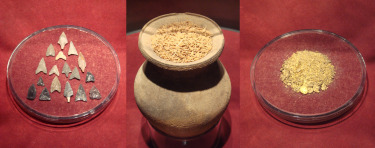Bitcoin as a rival digital commodity good: A supplementary comment
/ Japanese commodity money before the eight century. Source: Wikimedia Commons, PHGCOM.One of the challenges of interpreting bitcoin has been whether it can be classified under certain existing conceptual rubrics such as “money” or “commodity” for purposes of economic analysis. Could it be some strange new kind of “commodity money”? Most people immediately and intuitively dismiss this as a possibility because it is not a physical “thing,” which they feel is a defining characteristic of commodity-ness.
Japanese commodity money before the eight century. Source: Wikimedia Commons, PHGCOM.One of the challenges of interpreting bitcoin has been whether it can be classified under certain existing conceptual rubrics such as “money” or “commodity” for purposes of economic analysis. Could it be some strange new kind of “commodity money”? Most people immediately and intuitively dismiss this as a possibility because it is not a physical “thing,” which they feel is a defining characteristic of commodity-ness.
Resort to a word such as “token” seems a convenient escape valve from this situation. However, this could also be misleading. A token in a “token money” context derives its value from having a fixed exchange rate against something else—a 100 pennies for a dollar, a plastic chip for a euro, etc. Bitcoin, in contrast, is traded directly as itself, with utterly no sign of any fixed exchange or substitution rates (see my “
My newest paper, “Commodity, scarcity, and monetary value theory in light of Bitcoin” in The Journal of Prices & Markets (Winter 2015) explores some of these issues in detail from a formal conceptual standpoint to check such immediate and intuitive responses. The paper takes the time to define and then apply core economic-theory concepts, including goods, scarcity, and rivalry, as well as classical lists of “commodity money” characteristics, to understanding bitcoin in terms of monetary theory.
True, commodities are usually tightly associated with materiality. However, an economic-theory sense of commodity ought to be differentiable from a physical-descriptive sense. Economics begins with the study of choice and action, as distinct from issues addressed in physical sciences. It may be that the presence of materialness in commodities has just been assumed due to the nature of the available historical examples.
For a supplemental “reality check” beyond the obscure economics library, I thought to simply go and read the Wikipedia article on “Commodity.” This should be reasonably unlikely to represent any arcane or partisan definitions from one school of economics rather than another, and should first of all represent a general-purpose range of typical current understandings of the term.
I extracted some economic-theory elements from the entry, omitting illustrative examples. The examples are mostly material items, but this is to be expected due to the overwhelmingly pre-bitcoin scope of economic history so far. Indeed, part of my argument is that bitcoin may be the first rival digital commodity good (defined in the paper), which would mean precisely that it is unprecedented, a new type of example. Between the few excerpts below, I relate these presumably mainstream characterizations of commodity-ness to bitcoin.
Extracts from Wikipedia entry on “Commodity”
The exact definition of the term commodity is specifically used to describe a class of goods for which there is demand, but which is supplied without qualitative differentiation across a market. A commodity has full or partial fungibility; that is, the market treats its instances as equivalent or nearly so with no regard to who produced them. As the saying goes, “From the taste of wheat it is not possible to tell who produced it, a Russian serf, a French peasant or an English capitalist.”
No one generally considers which mining pool mined the block that a bitcoin originated in when deciding whether to accept payment. 50 Cent, for example, is unlikely to refuse bitcoin payments for his albums from anyone using coins mined by pools other than 50 BTC.
In the original and simplified sense, commodities were things of value, of uniform quality, that were produced in large quantities by many different producers; the items from each different producer were considered equivalent.
Multiple producers: All the various Bitcoin miners produce interchangeable new coins.
One of the characteristics of a commodity good is that its price is determined as a function of its market as a whole. Well-established physical commodities have actively traded spot and derivative markets.
There are numerous bitcoin spot markets and even some derivatives markets.
Commoditization occurs as a goods or services market loses differentiation across its supply base. As such, goods that formerly carried premium margins for market participants have become commodities, such as generic pharmaceuticals and DRAM chips. There is a spectrum of commoditization, rather than a binary distinction of “commodity versus differentiable product”. Few products have complete undifferentiability.
Coin tracking is sometimes cited as a risk for weakening the completeness of bitcoin fungibility, so while fungibility largely holds, there is some risk of entering onto a “spectrum of commoditization” in which some differentiation could creep in under certain circumstances.
Overall, I thought the entry was surprisingly clear in defining commodity in terms of economic rather than material concepts. While most of the examples of commodity were material, the economic meaning was conceptually independent of materiality. As should be expected, the discussion was about economic issues such as quality differentiation, pricing, market organization, and trading patterns—not chemistry. If we are using a term in economic analysis, a strictly economic definition should be most suitable.

